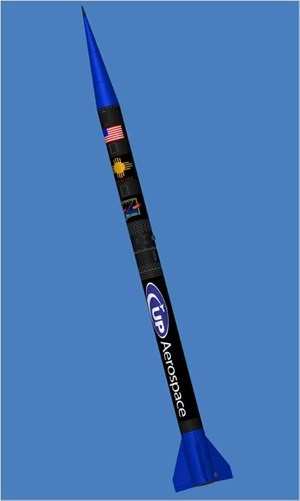No Major Anomalies Found So Far
 A representative with UP
Aerospace told ANN Friday the company has released its preliminary
analysis of the September 25 launch of its SpaceLoft XL rocket at
New Mexico's Spaceport America. From the company's findings so far,
it appears the rocket came VERY close to attaining its goal.
A representative with UP
Aerospace told ANN Friday the company has released its preliminary
analysis of the September 25 launch of its SpaceLoft XL rocket at
New Mexico's Spaceport America. From the company's findings so far,
it appears the rocket came VERY close to attaining its goal.
"We came within just 3 seconds of 100% success," said UP
Aerospace CEO Eric Knight to ANN. "If our SpaceLoft XL vehicle flew
on its trajectory for just another 3 seconds, it would have made it
all the way into space."
As Aero-News reported, the
rocket veered off its flight path approximately 10 seconds
following its inaugural launch from the new commercial spaceport in
southern New Mexico. The unusually lush desert landscape --
overgrown after record rainfall over the summer -- made recovery of
the rocket difficult; company officials finally located the rocket
five days later.
"We're homing-in on the cause of our flight anomaly," said Jerry
Larson, President of UP Aerospace. "As we suspected early on, we
have not seen any major issues. The entire vehicle -- from nosecone
to airframe to motor to fins -- remained structurally sound
throughout the entire flight. Everything was fine from launch,
through apogee, back through the atmosphere, to landing. There were
no premature flight events. All of the key systems were operating
as anticipated."
Larson continued, "All of our analysis and radar data confirms
that the rocket was traveling on a perfect trajectory towards
space. If it continued to fly on the same trajectory for just
another three seconds, and thus exiting the densest portion of the
atmosphere, it would have continued on its way into space. All of
the velocity and trajectory requirements were right on the mark for
a fully successful space flight."
"The subtlety of the anomaly is what is making the analysis a
little more time-consuming," Larson added. "But that, in itself, is
good news. A major anomaly would be quickly apparent. We've thus
been able to rule out many things that would be serious
issues."
Larson continued, "To assist in the investigation, the Spaceport
created an Anomaly Investigation Board. In tandem with the Board
and Spaceport personnel, we're combing through mounds of radar data
collected by our partners at the White Sands Missile Range. In a
very short time, we'll zero-in on the root cause, inform our Launch
Partners and the media, and start preparing for our next flights. I
think people will be surprised at how fast we return to flight
operations."
Larson says UP Aerospace has a full launch calendar from now
through 2008... but the company is being very cautious before
proceeding with future launches.
"Our next two rockets -- SL-2 and SL-3 -- are already built,
checked out, and ready to fly," he said. "The staff at Spaceport
America has been great in helping us get back on track for our next
launch, which is planned to take place before the end of this year.
We're looking forward to getting into a nice launch rhythm at
Spaceport America -- with up to two space-launches occurring there
per month."
UP Aerospace's SpaceLoft XL vehicle can launch up to 110 pounds
(50 kilograms) of scientific, educational, and entrepreneurial
payloads into space, with an altitude capability of up to 140 miles
(225 kilometers). The company is scheduling up to 30 space launches
per year from New Mexico's Spaceport America.
 ANN's Daily Aero-Linx (04.30.25)
ANN's Daily Aero-Linx (04.30.25) ANN FAQ: Turn On Post Notifications
ANN FAQ: Turn On Post Notifications Classic Aero-TV: Agile Aeros Jeff Greason--Disruptive Aerospace Innovations
Classic Aero-TV: Agile Aeros Jeff Greason--Disruptive Aerospace Innovations Aero-News: Quote of the Day (04.30.25)
Aero-News: Quote of the Day (04.30.25) ANN's Daily Aero-Term (04.30.25): Expedite
ANN's Daily Aero-Term (04.30.25): Expedite



